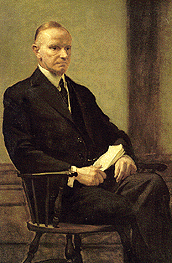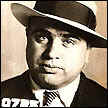The Tri-State Tornado Outbreak
This report has been divided into 4 Section
I – Understanding the EraThe Tri-State Tornado outbreak was a very tragic event in history. It contained the many of the worst event ever recorded from a storm, and holds many records still today. However to truly grasp the extent of the damage, you must first understand the era that the even took place in.
In 1925, the "Roaring 20’s" had already begun, and were strongly running near their peak. Calvin Coolidge, "distinguished for character more than for heroic achievement," (Biography of Calvin Coolidge) was president of the United States.
 (Picture
courtesy of whitehouse.gov)
(Picture
courtesy of whitehouse.gov)
Also around the United States, in an area where the very outbreak took place, a man named Al Capone became the leader of organized crime in Chicago.
 (Picture courtesy of about.com)
(Picture courtesy of about.com)
The idea of radar for use to detect weather had not been developed yet. After only a year, Sir Robert Alexander Watson patented the radar. This patent was neither American, nor for use in detecting weather. Though it would later be implemented into the weather system, it was developed to detect air raids over the skies of Great Britain.
Doppler Radar was invented in the following world war (II), based on the ideas Christian Andreas Doppler (whose experiments took place in 1842), and put into a visual format to detect moving objects by Doctor Robert Rines. As was the case with the conventional radar, it was developed for the military, and would later be implemented to help predict weather.
So much happened in 1925, and many weather-related technologies had not been developed yet. Now, hopefully, after that quick glance at the Era of 1925, the events of the Tri-State Tornado, and the outbreak, which it names, will be easily understood, and slightly more forthcoming.
II – The Tri-State Tornado Outbreak"All morning, before the tornado, it had rained. The day was dark and gloomy. The air was heavy. There was no wind. Then the drizzle increased. The heavens seemed to open, pouring down a flood. The day grew black…" - March 20, 1925 (St. Louis Post-Dispatch/by way of Interesting Quotes)
In a time with no radar, and little scientific weather prediction, few had any idea of the events that would soon take place. Gloomy, rainy days, are not uncommon, and few would have though little of it.
There are only 7 recorded tornadoes in the entire outbreak, only one has ever been written about. The reason that only the one tornado has ever been written about is because it shattered all records set by previous tornadoes, and it holds all those records through this day.
The Tri-State Tornado touched down near Murphysboro, Il at 1pm. It would forever go down in history as it passed through town after town to end up in Indiana when it finally dissipated.
The concept of a tornado family was not understood in 1925, so there very well may have been many more tornadoes that went unrecorded. Therefore the path on the recorded super tornado may have actually been more than one tornado.
Most tornadoes are fairly weak (40-112mph winds). The Tri-State Tornado (assuming it was one tornado) had winds over 300mph making it an F5 tornado, the strongest, conceivable, rating on the Fujita scale. Although wind speed alone is not the only factor in giving a tornado it’s Fujita rating. The damages that it caused everywhere it went were enough to confirm it’s rating.
Throughout the outbreak, over 740 lives were lost, 689 (a record for a single tornado) were lost in the one giant tornado. 2027 injuries were reported, and over 15,000 homes were completely destroyed.
The following records were recorded by the Tri-State Tornado:
 (drawing from Illinois Tornadoes by
John W. Wilson and Stanley A. Changon)
(drawing from Illinois Tornadoes by
John W. Wilson and Stanley A. Changon)
"It was so wide … usually you think about a tornado, it has a funnel, and it may be a block or two or three blocks wide. But something about a mile wide, well it just—" - Eugene Porter (75th Anniversary Web Page)
Oh yes it was wide, it averaged a 3/4quarter mile in width, but at times expanded to a mile wide. This actually contributed to the deaths as people could not recognize it as a tornado as it headed at speeds near 60mph straight at them.
The Tornado finally dissipated at 6pm, 10 miles northeast of Princeton. The tornado may have been gone, but the damage would be evident, and never forgotten.
It passed through 19 communities in 3 states, leaving near total damage everywhere it went. In the end many towns would never be rebuilt, and would forever live on as ghost towns.
III - AftermathAs I have already said, some of the towns that were destroyed by the tornado would remain as ghost towns and would never be rebuilt. Major towns, such as Murphysboro, Il were be rebuilt.
Partly as a result of the Tri-State Tornado Outbreak, the Nation Oceanic and Atmospheric Administration (which includes the National Weather Service), have developed the most complex and accurate forecasting systems on the face of the Earth.
In the end, such a catastrophic life toll may never be seen again, but a tornado as, or more powerful is inevitable. It is not a question of if such an event will ever happen again… It is truly a question of when, and if we will be ready.
Bardsley, Marilyn. Al Capone. About.com, 11 May 2003
<http://www.crimelibrary.com/2fcapone/2fgallery/2fgallery.htm>
Bellis, Mary. Radar and Doppler Radar Invention & History. About.com, 11 May 2003
<http://inventors.about.com/library/inventors/blradar.htm?terms=dappler+radar>
Changnon, Stanley A., Wilson, John W. Tornado Track. NOAA, 11 May 2003
<http://o-www.crh.noaa.gov.library.csuhaywood.edu/pah/1925/tt_frame.html>
Compiled by the History Channel. History Channel. History Channel, 11 May 2003
<http://www.historychannel.com/cgi-bin/framet.cgi?p=http://www.historychannel.com/perl/timeline.pl?year=1925>
Felknor, Peter S. Intesting Quotes. NOAA, 11 May 2003
<http://www.crh.noaa.gov/pah/1925/iq_body.html>
Friedel, Frank. , Sidey, Hugh S. Biography of Calvin Coolidge. The White House, 11 May 2003
<http://www.whitehouse.gov/history/presidents/cc30.html>
Pearson, Micheal. 1925 Monster Tornado. 18 March 2000. Tornado Warning Online,
5 May 2003 <http://utvols.8m.com/1925.html>
Poole, Beverly A. , Presley, Ryan J. 75th Anniversary Web Page. 1 October 2001. NOAA,
5 May 2003 <http://www.crh.noaa.gov/pah/1925/>
Tornado Project Online. 22 April 2000. Many Credible Sponsors, 7 May 2003
<http://www.tornadoproject.com>
Westa, Curtis D. Tri-State Tornado. Rootsweb, 6 May 2003
<http://www.rootsweb.com/~ilfrankl/tornado.htm>
© Shaun Shotwell 2003